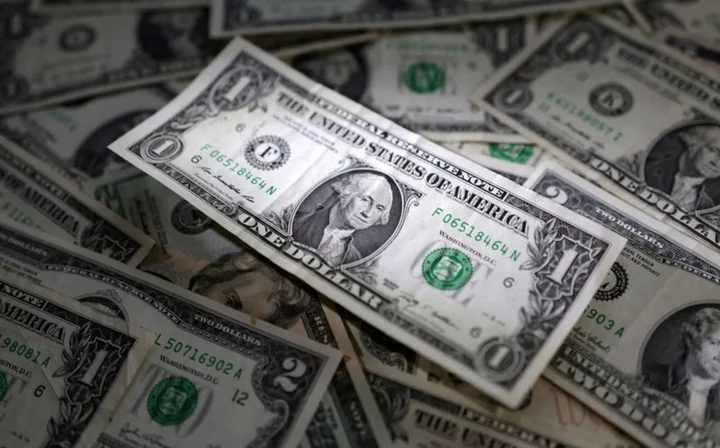By Jamie McGeever
ORLANDO, Florida Federal Reserve Chair Jerome Powell's speech in Jackson Hole is likely to maintain the 'higher for longer' outlook for U.S. interest rates and bond yields - good news for dollar bulls, especially given the contrasting picture elsewhere in the world.
While the U.S. economy appears to be humming along quite nicely - at a near-6% annualized rate, according to the latest Atlanta Fed tracking estimate - the same cannot be said for the its main rivals, most notably the euro zone and China.
The dollar had already clocked a two-month high against a basket of major currencies before Powell's keynote address at the Kansas City Fed's annual gathering of U.S. and global policymakers on Friday.
Short-dated yield spreads, typically a key driver of exchange rates, have been widening in recent weeks in favor of the dollar over most major currencies including the euro, sterling, yen and yuan.
While it's always dangerous to infer too much from market moves on any given day, especially days prone to knee-jerk reactions to major data or policy events, it is noteworthy that there was no pullback on Friday.
The two-year U.S. yield remained more than 200 basis points higher than its German equivalent, around the widest gap in favor of the dollar this year, and the U.S.-UK 2-year spread hit its widest in two and a half months.
The two-year U.S.-Japanese yield spread, meanwhile, spiked up towards the peaks from July and March that marked levels not seen since the year 2000.
"Yield spreads relative to other developed markets are likely to provide support for the dollar to move into a higher trading range," said Yung-Yu Ma, chief investment officer at BMO Wealth Management.
MIND THE GAP
If Powell's speech can be boiled down to a sentence or two, it is probably this: "...we will proceed carefully as we decide whether to tighten further or, instead, to hold the policy rate constant and await further data."
It is a 'win-win' for the dollar, at least in the coming weeks and possibly into year end. Further tightening is not yet priced into U.S. rates markets, so another quarter point hike will likely give the buck a boost.
Even if the Fed doesn't raise rates again, it is in no rush to cut them. That may change if the data suddenly deteriorates, but right now euro zone and UK rate curves are more vulnerable to a darkening growth outlook than the U.S. curve.
Money markets are still anticipating an almost one quarter-point rate hike from the European Central Bank this year and 65 bps from the Bank of England by next May. If the latest purchasing managers index reports are any guide, that pricing could be too optimistic - euro zone and UK activity are contracting at a rapid clip, according to the PMIs.
The bullish U.S. rate outlook relative to China and Japan is perhaps even more justified.
Facing deflation, an imploding property sector and deepening economic malaise, the People's Bank of China is reluctantly being forced to cut rates and loosen monetary policy. The U.S.-China yield gap, now the widest since 2007 when comparing 10-year yields, is unlikely to narrow much in the coming weeks.
The U.S.-Japan yield spread of more than 500 bps may be most vulnerable, given how wide it is. But the Bank of Japan has shown no inclination to follow its tentative 'yield curve control' tweaks with actual rate hikes, and Tokyo inflation data this week suggests national price pressures continue to ease.
The dollar is up 5% in the last six weeks, so a pause or profit-taking dip would come as little surprise. But as long as U.S. yields offer such a cushion, it shouldn't be long before the dollar is bouncing higher again.
(The opinions expressed here are those of the author, a columnist for Reuters.)
(By Jamie McGeever; Editing by Andrea Ricci)

